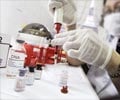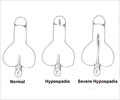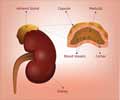- Ambiguous Genitalia And Disorders of Sexual Differentiation - (https://www.ncbi.nlm.nih.gov/books/NBK557435/)
- Chromosomal Sex Determination in Mammals - (https://www.ncbi.nlm.nih.gov/books/NBK9967/)
- 45,X/46,XY mosaicism: report of 27 cases - (https://pubmed.ncbi.nlm.nih.gov/10429013/#)
- Turner Syndrome - (https://www.ncbi.nlm.nih.gov/books/NBK554621/)
- Congenital adrenal hyperplasia - (https://pubmed.ncbi.nlm.nih.gov/15964450/#)
- Klinefelter syndrome - (https://pubmed.ncbi.nlm.nih.gov/9645824/)
- A Clinical Approach to Diagnosis of Ambiguous Genitalia - (https://www.ncbi.nlm.nih.gov/pmc/articles/PMC6568146/)
What is Ambiguous Genitalia?
Ambiguous genitalia, also referred to as atypical genitalia, is a birth defect where the genitals are not properly developed so as to differentiate the child as a male or a female().
It is a consequence of a group of disorders referred to as ‘disorders of sex development’. Ambiguous genitalia are not uncommon, and occur in 1 out of every 4000 newborns.
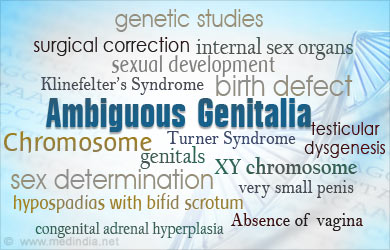
There are three factors that are important in the sex determination of a child:
- Chromosomes are the main determinants of the sex of an individual. Every cell has a pair of chromosomes called sex chromosomes. The sex chromosomes in males are XY, while the sex chromosomes in females are XX.
- The gonads or reproductive glands: These are present within the body. While the male has testes, the female has ovaries. The testes produce sperms while the ovaries produce ova or eggs.
- The external and internal sex organs: While the genitals are present at birth, further development of the genitals and development of secondary sexual characteristics takes place at puberty().
The formation of the external genitalia begins after the fetus is seven weeks old. Males develop the penis and scrotum, while female genitalia include the clitoris, labia majora, labia minora and the lower part of the vagina. The testis in males usually descend into the scrotum around the time just before the birth of the baby.
Disorders of sexual development (DSD) are classified as:
Sex chromosomal disorders: These include:
- Turner syndrome, where the patient has only one X chromosome(3✔ ✔Trusted Source
Turner Syndrome
Go to source), and Klinefelter’s syndrome, where the patient is male but with an additional X chromosome(). In these syndromes, the genitals are usually female and male respectively, and ambiguous genitalia are usually not noticed. In Klinefelter’s syndrome, the penis may be smaller than normal - 45, X/46, XY mosaicism, where the patient is usually predominantly male, but may sometimes appear like a female. Ambiguous genitalia are usually present().
- Ovotesticular DSD, where the patient has either both ovary as well as testis, or a combination of the two called ovotestis. Ambiguous genitalia are present. Development of breasts as well as penis may occur during adolescence.
Disorders of testicular development or disorders in androgen synthesis/action:
Patients with these disorders often have incomplete masculine genital features or appear like a female, although they have the Y chromosome.
Disorders of testicular development occur due to a failure of the testes to develop properly. These include:
- Complete testicular dysgenesis
- Partial testicular dysgenesis. Partially developed testes should be removed since they can turn cancerous.
- Vanishing testes syndrome, where the testes are likely to have been present initially, but regress later.
Disorders of androgen synthesis, i.e. synthesis of the male hormones testosterone and dihydrotestosterone, often due to abnormalities in enzymes involved in the production of these hormones in the body. Lack of androgens results in improper development of male genitals, thereby resulting in ambiguous genitalia.
In cases of partial or complete androgen insensitivity syndrome, the androgens may be present but the fetal tissues may not respond to them, and therefore, the development of male genitals may not take place.
Disorders of ovarian development or fetal androgen excess:
Patients with these disorders have the female sex chromosomes (XX), but show features of male external genitals. Some of the conditions that can produce excess androgen production in the fetus are:
- Presence of testis-like tissue in the body that produces androgens
- Congenital adrenal hyperplasia (CAH), which is a condition that usually occurs due to deficiency of an enzyme of the adrenal glands called 21-hydroxylase. As a consequence of this deficiency, more androgens are produced in the body. CAH can cause complications like low sodium or glucose levels, and should therefore be detected early().
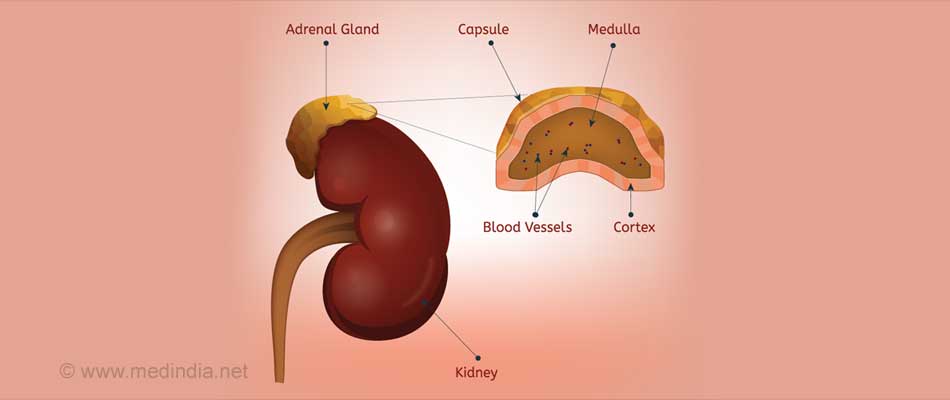
- Deficiency of the enzyme aromatase, which converts testosterone into estrogen. In cases of deficiency of this enzyme, more testosterone is produced as compared to estrogen, which results in the formation of male-type genitalia.
In addition, excess androgens present in the mother’s body due to an intake of certain medications or tumor producing androgens can also result in the development of male-type genitals in a female child.
What are the Symptoms of Ambiguous Genitalia?
There are various ways in which ambiguous genitalia can manifest. Ambiguous genitalia that make the child appear predominantly male include:
- Hypospadias, where the urethra is on the underside of the penis rather than on the tip
- Hypospadias with bifid scrotum
- Undescended one or both testes with hypospadias
- Bilateral non-palpable testes, where the testes cannot be felt in the scrotum
- Very small penis with the tip turned upward or downward(7✔ ✔Trusted Source
A Clinical Approach to Diagnosis of Ambiguous Genitalia
Go to source)
Ambiguous genitalia with female appearance include:
- Enlarged clitoris, which may appear like a penis
- Single opening in the labia
- Presence of a mass in the groin or labial region
- Absence of vagina
How to Diagnose Ambiguous Genitalia?
Approaches to the diagnosis of ambiguous genitalia, its cause and the sex determination of the child include:
- A complete history including a family history and any condition like intake of certain medications that could have affected the fetus during pregnancy
- A complete physical examination
- Measurement of hormones in the blood. hCG and ACTH stimulation tests are also used to assess the hormonal function of the testes and the adrenal glands.
- Ultrasound to study the gonads, the internal organs of the reproductive system and also to detect other associated anomalies
- Biopsy of the gonads identify the type and also to detect any tumor
- Genetic studies to check for chromosomal make-up of the baby(7✔ ✔Trusted Source
A Clinical Approach to Diagnosis of Ambiguous Genitalia
Go to source)

How do you Treat Ambiguous Genitalia?
Approach to the treatment of ambiguous genitalia has to be cautious since the condition not only has medical implications, but also affects the reproductive as well as psychosocial aspects of the affected individual. Counseling of parents is extremely important so that they can an take appropriate decision regarding the treatment of their child.
Surgical correction of the genitals is carried out based on the sex assigned to the patient. The surgery should be done at the time considered appropriate for each condition. It must be remembered that the way a person feels about his/her sex is also dependent on the development of the brain, both within the uterus as well as after birth. Therefore, sex assignment may not be completely straightforward in all cases.

People with ambiguous genitalia also often have other organ abnormalities like defect in the heart, kidney, etc. Therefore, it is necessary to have a complete checkup to diagnose these conditions, which should be treated as necessary. Patients with congenital adrenal hyperplasia may require urgent treatment.
Underdeveloped testis and ovaries may have to be surgically removed to prevent the development of cancer().


